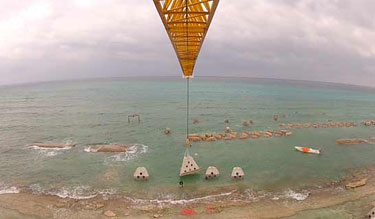A team of over 100 scientists,
ecologists, architects, engineers and divers are building a mile-long artificial coral reef off the coast of Mexico – the largest ever attempted.
It will slither down the Yucatan coast – starting just south of Cancun – bolstering the health of the second longest barrier reef in the world, which is suffering from climate change and rampant resort development. Not only will it protect the fragile shoreline from extreme storms, it will restore habitat for over 13,400 species of marine life. From above, it looks like a long serpent guarding the coast, thus its name, Kan-Kanán reef ("Guarding Serpent" in Mayan).
How It’s Made
Constructed out of 800+, 10-ton concrete pyramids, they are first painstakingly arranged along the shoreline. Then powerful cranes and specialized divers painstakingly place each pyramid on a concrete and micro-silica base.
Each pyramid is hollow and riddled with holes, mimicking the structure of a coral reef. The base provides a surface for algae, corals, and other invertebrates to attach to, drawing small sea life back and eventually leading to a thriving underwater sea habitat.

Nearby is another amazing project that doubles as a reef and an underwater museum. Built in 2009 in Isla Mujeres National Park, 500 concrete life-size sculptures stand at the bottom of the ocean! The idea is to draw people away from the natural reef to help it recover.

Lately, we’ve been writing a lot about efforts to save coral reefs, the first world ecosystem to reach a tipping point, says the IPCC in its most recent climate change report. Efforts include breeding super-strong reefs; artificially
inseminating them; using robots to repair reefs and simply reducing nitrogen and phosphorus runoff from farms to allow reefs to recover.
As the oceans warm from climate change, they become more acidic, which makes reefs more susceptible to disease and bleaching, starving them of the algae that’s essential to the food supply. Other factors like
overfishing, coastal development and pollution pose immediate risks, threatening more than 60% of coral reefs today.
Besides being among the world’s most biodiverse habitats, reefs play a critical role in protecting humans from rising sea levels and storms. They absorb the energy from waves, the best and cheapest way to protect shorelines.
Check out the underwater museum:
